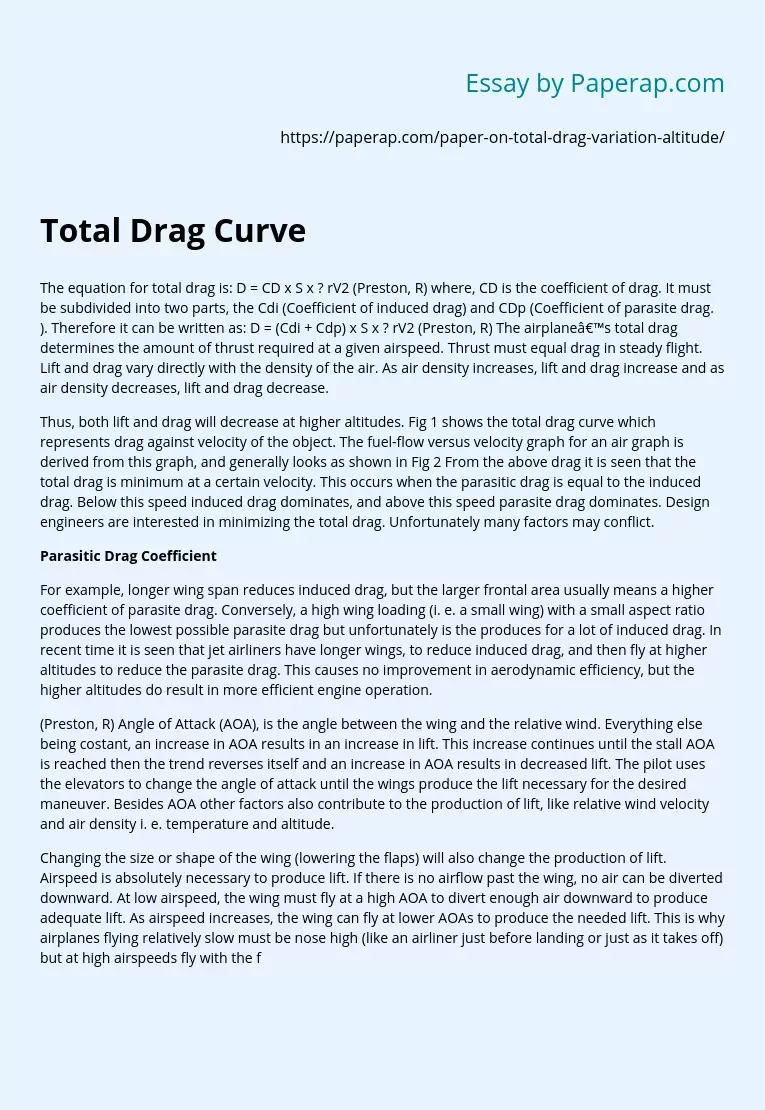Total Drag Curve
The equation for total drag is: D = CD x S x ? rV2 (Preston, R) where, CD is the coefficient of drag. It must be subdivided into two parts, the Cdi (Coefficient of induced drag) and CDp (Coefficient of parasite drag. ). Therefore it can be written as: D = (Cdi + Cdp) x S x ? rV2 (Preston, R) The airplane’s total drag determines the amount of thrust required at a given airspeed. Thrust must equal drag in steady flight. Lift and drag vary directly with the density of the air.
As air density increases, lift and drag increase and as air density decreases, lift and drag decrease.
Thus, both lift and drag will decrease at higher altitudes. Fig 1 shows the total drag curve which represents drag against velocity of the object. The fuel-flow versus velocity graph for an air graph is derived from this graph, and generally looks as shown in Fig 2 From the above drag it is seen that the total drag is minimum at a certain velocity.
This occurs when the parasitic drag is equal to the induced drag. Below this speed induced drag dominates, and above this speed parasite drag dominates. Design engineers are interested in minimizing the total drag. Unfortunately many factors may conflict.
Parasitic Drag Coefficient
For example, longer wing span reduces induced drag, but the larger frontal area usually means a higher coefficient of parasite drag. Conversely, a high wing loading (i. e. a small wing) with a small aspect ratio produces the lowest possible parasite drag but unfortunately is the produces for a lot of induced drag.
In recent time it is seen that jet airliners have longer wings, to reduce induced drag, and then fly at higher altitudes to reduce the parasite drag. This causes no improvement in aerodynamic efficiency, but the higher altitudes do result in more efficient engine operation.
(Preston, R) Angle of Attack (AOA), is the angle between the wing and the relative wind. Everything else being costant, an increase in AOA results in an increase in lift. This increase continues until the stall AOA is reached then the trend reverses itself and an increase in AOA results in decreased lift. The pilot uses the elevators to change the angle of attack until the wings produce the lift necessary for the desired maneuver. Besides AOA other factors also contribute to the production of lift, like relative wind velocity and air density i. e. temperature and altitude.
Changing the size or shape of the wing (lowering the flaps) will also change the production of lift. Airspeed is absolutely necessary to produce lift. If there is no airflow past the wing, no air can be diverted downward. At low airspeed, the wing must fly at a high AOA to divert enough air downward to produce adequate lift. As airspeed increases, the wing can fly at lower AOAs to produce the needed lift. This is why airplanes flying relatively slow must be nose high (like an airliner just before landing or just as it takes off) but at high airspeeds fly with the fuselage fairly level.
The key is that the wings don’t have to divert fast moving air down nearly as much as they do to slow moving air. Air density also contributes to the wing’s ability to produce lift. This is manifested primarily in an increase in altitude, which decreases air density. As the density decreases, the wing must push a greater volume of air downward by flying faster or push it down harder by increasing the angle of attack. This is why aircraft that fly very high must either go very fast e. g. Mach 3, or must have a very large wing for its weight.
This is why the large passenger airplanes cruise at higher altitude to reduce drag, and hence save on the furl costs. (“Aircraft for Amateurs”, 1999) Small sized aircrafts have lower than normal Reynolds number. The drag coefficient attributable to skin friction is hence higher for the small aircraft. For this reason, the maximum lift-drag ratios characteristic of business jet aircraft tend to be lower than those of the large transports. Hence, the smaller flights can fly at relatively lower altitudes.
References
Books John A. Roberson & Clayton T. Crowe, 1997, Engineering fluid Mechanics, 6th ed. , John Weily & Sons Inc., ISBN 0-471-14735-4. Clement Klienstreuer, 1997, Engineering Fluid Dynamics, Cambridge University Press, ISBN 0-521-49670-5 Websites “Aircraft for Amateurs”, 11th Jan. 1999 http://www. fas. org/man/dod-101/sys/ac/intro. htm Benson, T. , “The Beginner’s guide to Aeronautics”. , 14th March 2006 http://www. grc. nasa. gov/WWW/K-12/////airplane/ Johnston, D. , “Drag”, http://www. centennialofflight. gov/essay/Theories_of_Flight/drag/TH4. htm “Parasitic Drag”, http://adg. stanford. edu/aa241/drag/parasitedrag. html Preston, R. , “Total Drag” and “Flight Controls”, http://selair. selkirk. bc. ca/aerodynamics1/
Total Drag Curve. (2019, Dec 05). Retrieved from https://paperap.com/paper-on-total-drag-variation-altitude/

